

The Chronicles of Everstate: the future of the modern nation-state. As riots and protests have been progressively, and in an accelerating way, occurring in many countries, starting with France in 2005, as public deficits have become structural and entrenched, made more acute by the financial and economic crisis triggered in 2007 by the sub-primes, it became increasingly clear that something was happening at the very heart of our societies.

The political systems in which we live are under stress and changes are in the making. The end of the modern nation-state? By photographer Yiannis Biliris C.C. 3.0 Those very real events reflect a concern that has been underlined and debated in social sciences, notably international relations theory and political science for a long while, and most often expressed as the impending demise of the modern nation-state and related system. Already in 1977, Hedley Bull in his masterful The Anarchical Society was, among other, testing various hypotheses related to possible future evolutions of political systems. Navigating the Chronicles of Everstate. Check the embedded Pearltree below for automatically updated map – The featured image for this post is a snapshot of a map done with Pearltrees.

The Chronicles of Everstate: the Actors. Creating Everstate. Everstate is an imaginary state in our contemporary world of the beginning of the 21st century created to identify and imagine various futures.
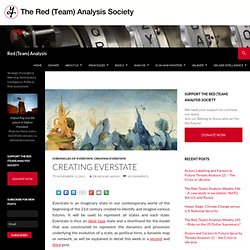
It will be used to represent all states and each state. Everstate is thus an ideal-type state and a shorthand for the model that was constructed to represent the dynamics and processes underlying the evolution of a state, as political form, a dynamic map or network, as will be explained in detail this week in a second and third post.
However, even if we work with an ideal-type, events do not unfold in a vacuum but are dependent and constrained by a host of specific factors, most notably geography, the ecological milieu and history. Thus to make our foresight at once realistic, replicable, as well as adaptable to specific, existing countries, some criteria need to be initially identified and then specified, i.e. we shall give them values for Everstate. Everstate’s characteristics. (Modified on December 19, 2010, 17:40 EST) The initial variables chosen to start building our scenario are the five most important variables according to Eigenvector centrality, as explained in Revisiting influence analysis.
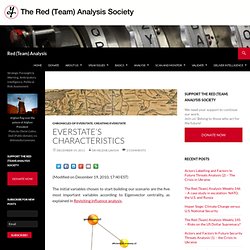
We shall now choose values for each criterion. Consistency is then checked, but only for the variables that are linked (see the consistency matrix). As we aim at finding a plausible and average, mild set of initial criteria, we shall start from the following set, which is also intuitively representative of the situation, real or perceived, in which many real world countries have found themselves for a couple of years. We then verify that the chosen scenarios are consistent with the consistency matrix. Everstate: Setting the stage (II. Last week’s summary: Everstate (An ideal-type for our very real countries created to foresee the future of the modern nation-state, to which we now attribute values to be able to develop the scenarios) is a middle-range power located on the Eurasian land mass and part of the international liberal order.

It is ruled under a democratic parliamentary regime and obeys an array of norms and their institutional administrative offshoots at international, regional and national level. Its governance is thus complex. Lately, it started being less efficient and as a result began to fail to ensure the security of Everstate’s citizens. (Click on each picture to see a larger version in a new tab). 2013 – 2018 EVT – Tragic events. The tragic events that strike Everstate are instances of the various conditions presiding to Everstate’s destiny, considering what has been done, or not, globally, regionally and within Everstate.
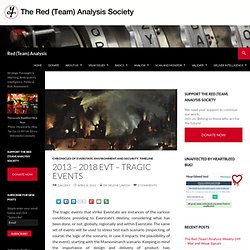
The same set of events will be used to stress test each scenario (respecting, of course, the logic of the scenario, in case it impacts the plausibility of the event), starting with the Mamominarch scenario. Keeping in mind the importance of design and delivery of product, two web-applications to present timelines have also been tested in this post (see pictures below, click or use embedded app – warning: the embedded app returns an error message on tablets and mobiles, sorry, just skip it until the text).* Pressures and events that could take place in the short to medium-term future (up to 10 years). Everstate: Setting the stage (I. For explanations regarding the methodology used to develop the narrative, see the post “Constructing a foresight scenario’s narrative with Ego Networks.”
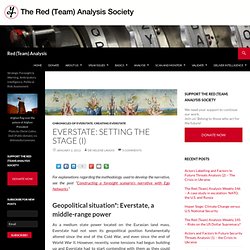
As a medium state power located on the Eurasian land mass, Everstate had not seen its geopolitical position fundamentally altered since the end of the Cold War, and even since the end of World War II. However, recently, some tensions had begun building up and Everstate had to start contending with them as they could easily transform in very concrete new external military threats. What had contributed to maintain its geopolitical position were different factors. If the impact that its ecological setting could have had on its geopolitical position was remote and long forgotten, it nevertheless still played a part. Similarly, its continental climate, soften for the southeastern part by the influence coming from the sea, was not seen as a factor influencing geopolitics anymore. In Everstate, central order was relatively strong. 2012 EVT: Rising Discontent (The Chronicles of Everstate. Last weeks’ summary: Everstate (an ideal-type for our very real countries created to foresee the future of the modern nation-state) is part of the international liberal order and ruled under a democratic parliamentary regime.

Lately, its governance started being less efficient and as a result began to fail to ensure the security of Everstate’s citizens. Meanwhile, its economy showed sign of losing efficacy and its powerful elite groups fought hard to keep their status although they do not believe to be really at risk. The various degradations and tensions have started being felt and registered by the population. However, most Everstatan actors considered those as temporary crises and difficulties that will be shortly solved. At worst, some envisioned a serious crisis that would last a few years, maybe a decade of slow growth before everything went back to normal. First, obvious new external military threats have arisen from foreign groups trying to implement their own state power.
2012 EVT: Seeking Security (The Chronicles of Everstate. Last week’s summary : In 2012 EVT, in Everstate (the ideal-type corresponding to our very real countries created to foresee the future of the modern nation-state ), the population’s discontent increases – and is bound to continue to do so – as a result of various pressures and threats, most of them inevitable, imperfectly identified, and not understood. Indeed, Everstatans feel both directly and indirectly the impact of those pressures, which affect their sense of security and thus generate discontent. (The reader can click on each picture to see a larger version in a new tab).
Everstatans continue to seek a security that is appearing as increasingly distant and elusive . They turn to their political authorities, expecting them to deliver this security. Indeed, Everstatans believe that their government, their state (which assists the ruler in its tasks) and their national representatives, being their legitimate political authorities, should ensure their security. To be continued … 2012 EVT: Ideological Stakes in an Outdated Worldview (The Chronicles of Everstate. Last week’s summary: In 2012 EVT, Everstate (the ideal-type corresponding to our very real countries created to foresee the future of the modern nation-state) knows a rising dissatisfaction of its population.

2012 EVT: Material Stakes in an Outdated Worldview (The Chronicles of Everstate. Last week’s summary: In 2012 EVT, Everstate (the ideal-type corresponding to our very real countries created to foresee the future of the modern nation-state) knows a rising dissatisfaction of its population as authorities cannot anymore deliver security.
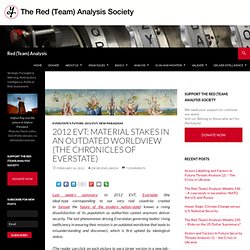
The last phenomenon driving Everstatan governing bodies’ rising inefficiency in ensuring their mission is an outdated worldview that leads to misunderstanding and disconnect, which is first upheld by ideological stakes. (The reader can click on each picture to see a larger version in a new tab - a navigating map of posts is available to ease reading). The knowledge institutions and related people, which are guardians of norms and thus have ideological stakes in upholding an outdated worldview, are also motivated by material stakes in seeing norms respected, upheld and continuing. Indeed, their institutional survival depends on the continuation of those models, for example, through funding and employment.
But what can be done?
Scenario 2: Panglossy. Scenario 1: Mamominarch. 2012 EVT: Public Resources and Lenders (The Chronicles of Everstate. Last week’s summary: In 2012 EVT, Everstate (the ideal-type corresponding to our very real countries created to foresee the future of the modern nation-state) sees a mounting discontent of its population because it has become insecure considering the impact of the new still misunderstood conditions. Three related phenomena drive Everstatan political authorities’ incapacity to deliver security.
First, Everstate faces a changing set of resources implying an income that is relatively too low while costs and expenditures resulting from accumulated threats and pressures rise inexorably. 2012 EVT: the Power of Novstate (The Chronicles of Everstate. Last week’s summary: In 2012 EVT, the deepening chronic budget deficit and the rising need for liquidity of Everstate (the ideal-type corresponding to our very real countries created to foresee the future of the modern nation-state) give an increasing power to the lenders elite group, allowing for new forms of appropriation of public power. Everstate sinks into a vicious circle.
(The reader can click on each picture to see a larger version in a new tab).
Indications: Public resources & lenders. 2012 EVT: Budget Deficit and Liquidity (The Chronicles of Everstate. The first phenomenon driving Everstatan political authorities’ incapacity to deliver security is a deepening budget deficit and an increasing need for liquidity The resources that participate into obtaining the income necessary to govern have started being impacted by the novel threats and by the evolution in general a few years ago.
However, this change happened unnoticed by most and is still largely ignored as new pressures are yet to be recognised. In general, the focus of awareness is on forthcoming so-called resource wars*, generated by the probable end of cheap abundance that is likely to affect natural resources such as water, oil or minerals, and the scrambling for components in new substitutes such as rare-earth elements . Yet, the problem is more complex and also far worse.
Indications: Rising discontent & pressures.